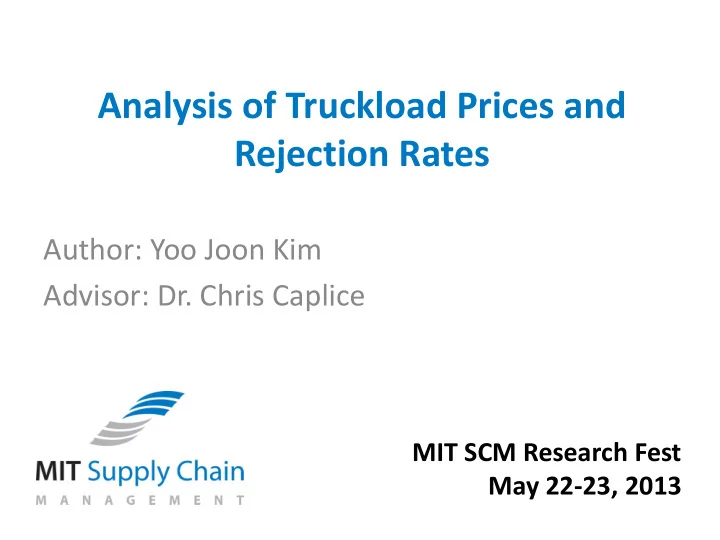

Analysis of Truckload Prices and Rejection Rates Author: Yoo Joon Kim Advisor: Dr. Chris Caplice MIT SCM Research Fest May 22-23, 2013
Agenda • Introduction: • The Truckload Industry • Tender Rejection • Research Question • The Dataset, Methodology, and the Key Variable • Analysis and Results • Conclusion May 22-23, 2013 MIT SCM Research Fest 2
Truckload (TL) industry • 33% of the domestic freight Tonnage shipments in the U.S. in 2011 Pipeline Water 10.6% 6.6% • Total TL industry revenue: Air 0.1% $280.2 bn Rail inter- Truckload modal 33.1% • Direct shipment from origin to Rail 1% 14.4% destination based on the shippers’ demand Less- Private than- truck truckload 32.9% • Highly competitive with 45,000 1.0% carriers in the market Source: S&P (2013) May 22-23, 2011 MIT SCM Research Fest 3
Strategic TL procurement • Complex transportation network consisting of thousands or hundreds of lanes • Large shippers hold private auctions and use optimization methods to select carriers with the best price • One or more primary carriers are assigned to each lane • Long-term (one year or longer) contracts, but not binding • The carrier selection results are placed into a “routing guide” May 22-23, 2013 MIT SCM Research Fest 4
Tender rejection • According to the routing guide, shippers assign loads to primary carriers (“tender”) • The tender is accepted or rejected by the primary carrier • When rejected, the shipper has to find alternative carriers and, most of time, the truckload price for the load increases May 22-23, 2013 MIT SCM Research Fest 5
Why do carriers reject tenders? • Carrier economics = cost of linehaul + cost of connection • Empty miles, long waiting times, extra load/unload times May 22-23, 2013 MIT SCM Research Fest 6
Hypothetical reasons • Long-haul shipments: • Uncertainty of follow-on loads • Drivers’ hours of service • Inconsistent volume • Rates are too low • Not enough lead time May 22-23, 2013 MIT SCM Research Fest 7
Research question: Can we predict rejections? • Do tender rejections occur in a specific location? • Can the length of haul explain tender rejections? • If volume is highly volatile, do carriers frequently reject tender? • Is there any relationship between tender rejection and truckload price? • Should shippers whose objective is to minimize costs unconditionally aim to eliminate rejections? May 22-23, 2013 MIT SCM Research Fest 8
The Dataset • 17 shippers, 5 market segments • TL transactions from 1/1/2008 to 9/30/2012 • 49 states, 3,000 cities and 17,000 lanes • Total 2,384,680 tenders to secure trucks for 1,670,104 loads (average 1.43 tenders per load) May 22-23, 2013 MIT SCM Research Fest 9
Regression analysis • Linear regression analysis to quantify the impact of explanatory variables • Dependent variable: weekly rejection rate • Explanatory variables: • Average length of haul • Coefficient of variation (CV) of weekly volume over a year May 22-23, 2013 MIT SCM Research Fest 10
Rejection rate Weekly rejection rate = 5/62 = 8% Day Mon Tue Wed Thu Fri = 62 No. of loads 20 1 20 1 20 No. of rejected 1 1 1 1 1 = 5 loads Daily rejection 5% 100% 5% 100% 5% rate Average = 43% Destination Origin “Lane” (3-digit zip code) (3-digit zip code) May 22-23, 2013 MIT SCM Research Fest 11
Frequent rejections 19.8% of the total loads rejected by the primary carriers May 22-23, 2013 MIT SCM Research Fest 12
Price escalation • For 80.8% of the rejected loads, shippers paid on average 14.8% above their primary rates May 22-23, 2013 MIT SCM Research Fest 13
Geographic pattern of rejections May 22-23, 2013 MIT SCM Research Fest 14
Geographic pattern of rejections May 22-23, 2013 MIT SCM Research Fest 15
Length of haul and rejection Length of Haul, miles (bin) May 22-23, 2013 MIT SCM Research Fest 16
Length of haul and rejection • The length of haul itself was not a good predictor of the rejection rate for a given lane • Regression analysis: • Dependent variable: weekly rejection rate for a lane • Independent variable: the average length of haul of a lane • R 2 : • Short-haul (less than 100 miles): 3.5% • Long hauls (100-400 miles): 0.2% May 22-23, 2013 MIT SCM Research Fest 17
Length of haul and rejection 100-125 miles Avg. rejection rate = 28.1% Avg. rejection rate = 28.1% Rejection Rate (bin) Length Of Haul, miles (bin) May 22-23, 2013 MIT SCM Research Fest 18
Volume variability and rejection • Variability of volume was a better predictor of the rejection rate than length of haul • Regression analysis: • Dependent variable: weekly rejection rate of a lane • Independent variable: coefficient of variation (CV) of weekly volume over a year for a lane • R 2 : • Short-haul (less than 100 miles): 20.4% • Long hauls (100-400 miles): 6.7% May 22-23, 2013 MIT SCM Research Fest 19
Volume variability and rejection CV of Weekly Volume (bin) May 22-23, 2013 MIT SCM Research Fest 20
Truckload price and rejection rate • Linehaul rate per mile by rejection rate, for 100-250 miles +14.8% Average = $2.38/mile Rejection Rate (bin) May 22-23, 2013 MIT SCM Research Fest 21
Trade-off between price and rejection? • Truckload price vs. rejection rate for the origin zip code “60 - ” May 22-23, 2011 MIT SCM Research Fest 22
Trade-off between price and rejection? truckload price (linehaul rate per mile) = $2.62 + -$0.36 x rejection rate + $0.67 x (rejection rate) 2 + error optimal May 22-23, 2011 MIT SCM Research Fest 23
Conclusion • Rejections occurred without spatial and temporal pattern. • Neither length of haul nor variability of volume sufficiently explained tender rejection for a given lane. • The data suggested potential trade-off between tender rejection and truckload prices. • Shippers need to look for an optimal point in this trade-off in order to minimize transportation costs. May 22-23, 2013 MIT SCM Research Fest 24
Recommend
More recommend